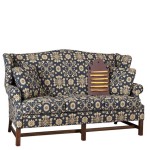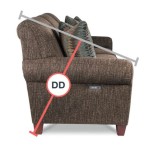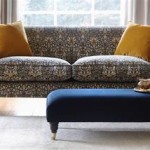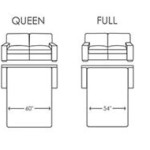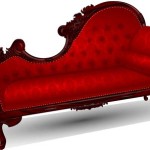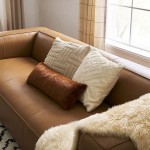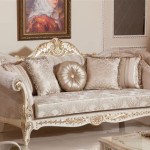Designing a Multifunctional Home Office with a Sofa Bed
The modern work landscape has witnessed a significant shift towards remote and hybrid work models. Consequently, the demand for dedicated home office spaces has surged. However, space limitations often present a challenge, especially in urban dwellings. A strategically designed home office that incorporates a sofa bed can effectively address this challenge, offering a dual-purpose solution that caters to both work and occasional guest accommodation.
Integrating a sofa bed into a home office design requires careful consideration of several factors, including space optimization, furniture selection, lighting, and overall aesthetics. The key lies in creating a functional and comfortable workspace that can seamlessly transform into a welcoming guest room when needed. This necessitates a holistic design approach that prioritizes both practicality and visual appeal.
Optimizing Space and Layout
The first step in designing a multifunctional home office is to assess the available space and develop a layout that maximizes its utility. The placement of the sofa bed is crucial, as it will be the largest piece of furniture in the room. Ideally, the sofa bed should be positioned against a wall to minimize its intrusion into the workspace when in its sofa configuration. Consider the clearance required when the sofa bed is fully extended into its bed configuration. Measure the room dimensions accurately and map out the furniture placement to ensure that there is sufficient space for movement and functionality in both configurations.
Vertical space utilization is also paramount. Shelving units, wall-mounted cabinets, and floating desks can significantly increase storage capacity without occupying valuable floor space. These storage solutions can house office supplies, books, and other items, keeping the workspace organized and clutter-free. Furthermore, tall, narrow storage units are preferable to wide, bulky ones, as they tend to take up less floor area.
Consider the flow of traffic within the room. The layout should facilitate easy movement between the desk, sofa bed, and other furniture pieces. Avoid placing furniture in a way that obstructs doorways or creates bottlenecks. A well-planned layout will contribute to both the functionality of the office space and the comfort of guests when the sofa bed is in use.
Another important aspect of space optimization is the selection of space-saving furniture. Folding desks, nesting tables, and mobile storage carts can be easily stowed away when not in use, freeing up valuable space. These versatile furniture pieces allow for flexibility and adaptability, making the home office suitable for various purposes. For example, a folding desk can be folded away to create more space for guests to move around comfortably when the sofa bed is deployed.
Selecting the Right Sofa Bed and Desk
The choice of sofa bed is a critical decision that directly impacts the comfort and functionality of the multifunctional space. Selecting a sofa bed that is both comfortable as a sofa and as a bed is essential. Consider the quality of the mattress, the ease of conversion, and the overall design aesthetic. Memory foam mattresses are generally considered more comfortable than traditional innerspring mattresses. Look for sofa beds with a sturdy frame and a smooth, easy-to-use mechanism for converting between sofa and bed configurations.
The style of the sofa bed should complement the overall design of the home office. A sleek, modern sofa bed with clean lines will blend well with a contemporary office aesthetic. A more traditional sofa bed with tufted upholstery may be more suitable for a classically styled office. The color and fabric of the sofa bed should also be carefully considered, as they will contribute to the overall visual appeal of the room. Neutral colors are generally a safe bet, as they tend to be more versatile and can be easily coordinated with other furniture and décor.
Equally important is the selection of a suitable desk. The size and style of the desk should be appropriate for the available space and the tasks that will be performed in the office. A large, expansive desk may be ideal for those who require ample workspace for spreading out documents or using multiple monitors. A smaller, more compact desk may be sufficient for those who primarily use a laptop or perform tasks that require less surface area.
The desk should be ergonomically designed to promote good posture and reduce the risk of strain or injury. Adjustable-height desks are a popular choice, as they allow users to switch between sitting and standing positions, which can help to alleviate back pain and improve overall health. The desk should also be positioned in a way that maximizes natural light and minimizes glare on the computer screen. Consider the placement of power outlets and cable management solutions to keep the workspace tidy and organized.
Furthermore, consider the material of the desk. Wood desks offer a classic and professional look, while metal desks are more durable and often more affordable. Glass desks can create a modern and airy feel, but they may require more maintenance to keep them clean. Choose a desk material that is both aesthetically pleasing and practical for the intended use.
Incorporating Lighting and Storage Solutions
Adequate lighting is essential for a productive and comfortable home office environment. Natural light is ideal, but it is not always available or sufficient, especially during evening hours or in rooms with limited windows. Therefore, a combination of ambient, task, and accent lighting is recommended.
Ambient lighting provides overall illumination to the room. This can be achieved through overhead fixtures, such as recessed lighting or a pendant lamp. Task lighting is focused on specific work areas, such as the desk. A desk lamp with an adjustable arm and brightness control is ideal for providing targeted illumination for reading, writing, or computer work. Accent lighting is used to highlight specific features or décor elements in the room, such as artwork or shelving units. This can be achieved through wall sconces, spotlights, or LED strip lights.
The color temperature of the lighting is also an important consideration. Cool white light is generally preferred for tasks that require focus and concentration, while warm white light is more suitable for creating a relaxing and inviting atmosphere. Consider using dimmable lighting fixtures to adjust the brightness and color temperature according to the time of day and the task at hand.
In addition to lighting, storage solutions play a crucial role in maintaining a clutter-free and organized home office. As mentioned earlier, vertical space utilization is key. Shelving units, wall-mounted cabinets, and floating desks can significantly increase storage capacity. Consider using storage containers, baskets, and drawer organizers to further compartmentalize and organize office supplies and other items.
Choose storage solutions that are both functional and aesthetically pleasing. Opt for storage units that complement the overall design of the home office. For example, wooden shelving units can add warmth and character to a traditional office, while metal shelving units can create a more modern and industrial look. Consider using open shelving to display books, plants, and other decorative items. This can add personality and visual interest to the room.
Closed storage, such as cabinets and drawers, is ideal for concealing items that you want to keep out of sight. This can help to maintain a clean and uncluttered appearance. Labeling storage containers and drawers can also help to keep things organized and easy to find. Consider using a combination of open and closed storage to create a balance between functionality and aesthetics.
Furthermore, consider investing in a filing cabinet or portable file organizer to store important documents and paperwork. Keep files organized and labeled for easy retrieval. Shred any documents that are no longer needed to prevent clutter and protect sensitive information.
The successful integration of a sofa bed into a home office design requires meticulous planning and thoughtful consideration of space optimization, furniture selection, lighting, and storage solutions. By carefully addressing these factors, it is possible to create a multifunctional space that is both functional and aesthetically pleasing, catering to both work and occasional guest accommodation.

A Small Yet Clean Home Office With Wooden Trestle Leg Desk By The Window And Grey Sofa T Guest Room Combo Bedrooms

A Create Perfect Interior Design Project House Tour Guest Bedroom Home Office

25 Versatile Home Offices That Double As Gorgeous Guest Rooms Bedroom Design Bedrooms Room Office

Small Home Office Design Two Plans Shabbyfufu Com

Simple Ways To Turn Your Home Office Into A Dreamy Guest Room Jmorris Design Llc

Interior Design Guest Room Studio Welcome Splendor Styling Interiors Dc Md Va

Using A Second Bedroom As Home Office And Guest

Office Sofa Set Photos Ideas Houzz

25 Versatile Home Offices That Double As Gorgeous Guest Rooms Decoist

These Days More And People Are Working At Home Some Of Them Employer Fo Living Room Office Combo Contemporary

